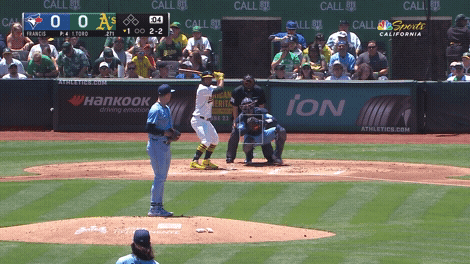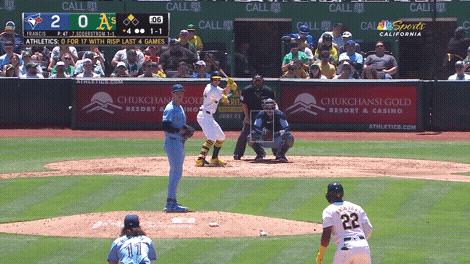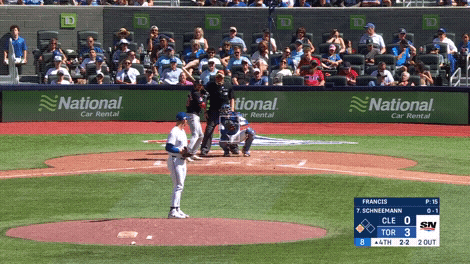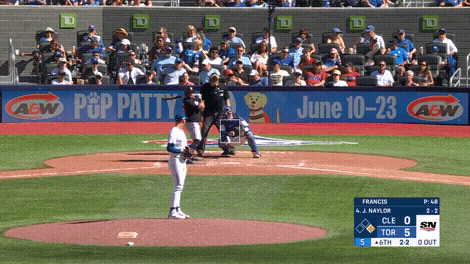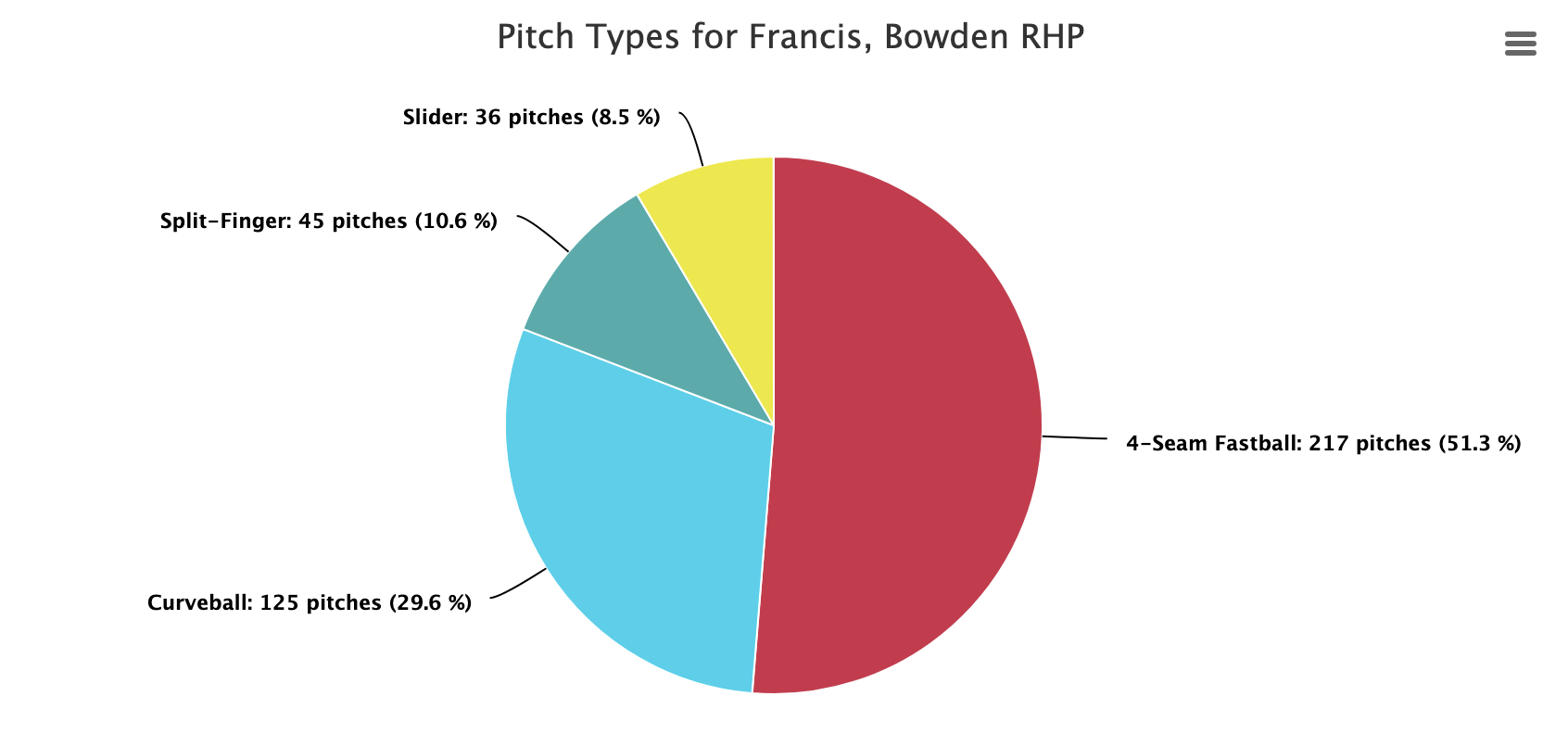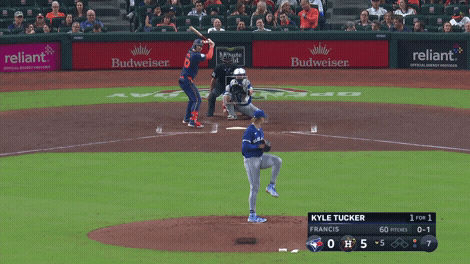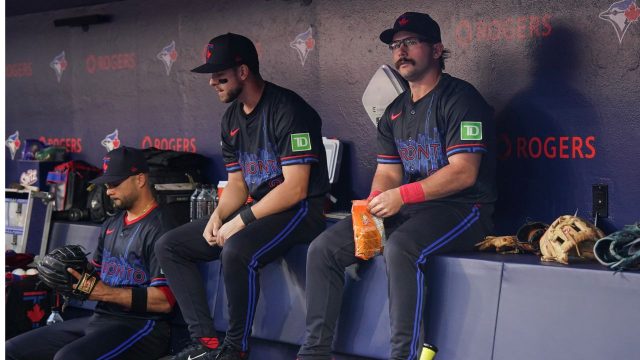The first splitter grip Bowden Francis tried wasn’t aggressive enough. His index and middle fingers were split around the narrower gap in the baseball’s seams, widening along with the seams with the horseshoe at the bottom of his grip.
The second grip he tried went far in the other direction, stretching his fingers around the widest part of the ball’s seam pattern, spread more than two inches apart at the first knuckles. The ball came out of his hands more like a forkball, almost knuckleball-like in its lack of spin.
It was a third grip, shown to him by teammate Chris Bassitt, where Francis found the goldilocks point, a grip that was aggressive enough to generate unique movement but not so aggressive that he couldn’t induce consistent spin. This “one-o-clock” grip still splits the fingers, but the index fingers stays along one seam to create a rip effect down the seam when he releases it, with the middle finger aggressively tucked wide to the outside of the ball.
The grip is similar to the one Bassitt uses himself, although Bassitt inverts the seam direction for a slightly different release. Bassitt helping Francis tweak the pitch is hardly surprising; Bassitt also helped encourage Kevin Gausman to reintroduce his two-seam fastball and enjoys breaking down other pitchers and which pitches work well off each other. He also throws eight different pitches of his own and has a knack for manipulating and understand spin.
“I think he forgets about some of his pitches,” Francis joked.
Early in the year, it seemed like Francis had maybe forgotten about his splitter, too. You’ve probably noticed him grip the ball with his fingers split, upon receiving it back from his catcher, more than you’ve noticed the actual pitch (this is so anyone peaking for his grip as a way of tipping his pitch will always see a split grip initially). He’d only thrown it in games a few times while introducing it in spring training, and then threw it just 30 times over his first seven regular season appearances. It was being deployed as merely a show-me weapon, to mix things up and maybe catch a hitter off-guard, but the movement when Francis did throw it was encouraging.
While on a rehab assignment in Buffalo, Francis increased the usage of the pitch to improve his feel and comfort level with it. He threw 28 over four appearances, 17 percent of his total pitches, primarily when ahead in the count. The result was a handful of swing-and-miss, a lot of very weak contact, and only one hit.
“That’s the time to work on stuff, when you’re down there,” Francis said. “It was just something I was feeling comfortable with. It’s good for lefties. I threw some to righties. The catchers down there kept saying it makes the heater play better.”
When Francis returned to the majors, it wasn’t immediately a threat, in part because going to a new, developing fourth pitch isn’t often the answer when a pitcher is struggling with his main stuff, as Francis did in his return. The next time out, catcher Danny Jansen called for it a bit more. The Jays liked what they saw from it.
On Saturday against a lefty-heavy Cleveland Guardians lineup, Jansen called for it more than ever before. Francis fired 15 splitters in that game, by far the most he’s thrown in an outing in his career. In a 2-2 count with a runner on in the fourth, Francis sat down Daniel Schneemann with a bad swing at a splitter. In the sixth, he got dangerous power hitter Josh Naylor to roll over a splitter and into a double-play.
“I guess it’s feeling pretty good,” Francis said Monday. “I think just throwing it more. Get a good feel for it.”
The increased usage was largely driven by Jansen. Francis, who operated with a three-pitch mix last season, mostly goes with his catchers’ suggestions when on the hill, and hasn’t shaken off a sign in order to get to the splitter yet.
“Sometimes when it’s your fourth pitch, when you get in the game, all of a sudden you kind of forget about it. They’re flashing it, so it gives me confidence in it,” he said.
There are a few reasons to like the idea of a splitter for Francis moving forward.
One of the ideas behind splitter usage increasing across baseball is that the splitter is a platoon-neutral pitch. That is, it is statistically as effective against hitters on either side of the plate, whereas breaking balls that move right-to-left (for a right-handed pitcher) tend to give an advantage to opposite-handed hitters. Righties have actually hit Francis better than lefties in his small major league sample, but on paper, another weapon to neutralize lefties is important if Francis is going to return to a rotation at any point.
Francis had tried to introduce a changeup in the past for a similar effect on lefties. Pronating for a changeup, like how Trevor Richards throws his, wasn’t natural to Francis, and so he struggled to find a changeup with enough depth. The splitter is an off-speed weapon and his carries some similar arm-side movement.
The two breaking balls he throws, the curveball and the slider, both move in the same direction off of his fastball. The slider has a shorter movement right-to-left, while the curveball has a sweepy two-plane movement in the same direction. His fastball, meanwhile, is one he uses up in the zone a lot, which is the type of four-seam fastball that splitters can play off of well if the pitcher tunnels (keeps a consistent arm action) well.
“I think it’s good to have something to go that way,” Francis explained. “The heater has that run, so that same kind of run for the splitter, way separated. It’s kind of the same lane but way more depth. I’m learning how to use it as a tool and not get too dependent on it.”
There is still work to come on the pitch. There’s a reason so few pitchers are able to throw it regularly despite strong league-wide results.
Francis’s spin rate – which he’s been tracking regularly since the offseason with Trackman readings that provide information on spin rate, movement in multiple directions, and spin axis – isn’t at the particularly high or low end among splitters, though the consistency of the spin (and, hence, the movement) is often more important. Getting a bit more run back away from lefties could also help. And it’s a pitch that will live outside the zone yet probably needs to miss by a little less than it has been to induce more chase.
If he’s used in shorter bursts with the impending return of Yariel Rodriguez, too, there may not be as much of a need for a fourth pitch. And only 63 innings into his major league career, there’s still a lot to learn, which goes beyond just improving his arsenal.
“He’s just still so young, you still don’t truly know what big-league hitters are trying to do to you. He’s still trying to learn kind of who he is, similar to what almost every one of us did,” Bassitt said. “So it’s hard to say ‘Bowden needs a splitter.’ I think it could be a very big weapon for him. It’s just, I mean, we’ll see.”
Even if Francis shifts back into a shorter relief role, the additional weapon to keep left-handed hitters in check – and potentially miss bats – gives John Schenider more options with what pockets of a lineup to use Francis in, and how long he can let him go. Longer-term, a reliable fourth pitch could help Francis build from a length role into a starting option, similar to how it’s helped Tanner Houck or Taj Bradley.
The early returns are encouraging, and surely worth the effort of trial-and-erroring several painful-looking grips.


